Reptiles and Amphibians
Media
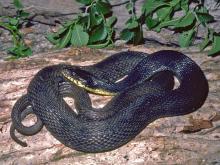
Species Types
Scientific Name
Nerodia erythrogaster
Description
The plain-bellied watersnake is a medium-sized, heavy-bodied, dark-colored, semiaquatic snake with a plain yellow belly. It's present in the Bootheel and north along the Mississippi River floodplain, and along our southernmost counties and northward in western Missouri into parts of northwest Missouri.
Media
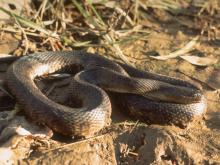
Species Types
Scientific Name
Nerodia cyclopion
Description
The Mississippi green watersnake is a medium-sized, heavy-bodied, dark-colored semiaquatic snake that was once somewhat common in southeastern Missouri. It probably no longer occurs in our state at all.
Media
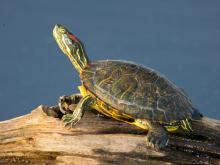
Species Types
Scientific Name
Trachemys scripta elegans
Description
The red-eared slider is an attractive aquatic turtle with yellow pinstripes and red ears. It is commonly seen basking on logs or rocks and occurs statewide, except for a few northern counties.
Media

Species Types
Scientific Name
Opheodrys vernalis
Description
The smooth greensnake has been declared extirpated from Missouri. If it is ever found again within our borders, it will probably be as small, relict populations in grasslands in the extreme northern counties. It differs from the similar rough greensnake by having smooth scales, a preference for grassland habitats, and a more northern distribution in Missouri.
Media
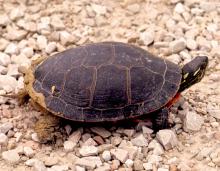
Species Types
Scientific Name
Chrysemys picta bellii
Description
The western painted turtle is a small, brightly colored aquatic turtle. The upper shell is smooth and has a red-orange outer edge. The colorful lower shell has a prominent pattern of brown markings. It is found nearly everywhere in the state except the southeast region.
Media
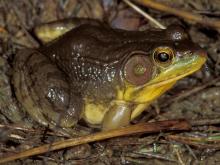
Species Types
Scientific Name
Lithobates clamitans (formerly Rana clamitans)
Description
The green frog looks similar to a bullfrog but is smaller and has a ridge of skin along the sides of the back that is not found on bullfrogs. It is a game animal in Missouri.
Media
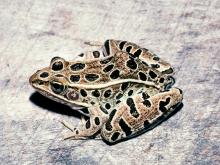
Species Types
Scientific Name
Lithobates pipiens
Description
The northern leopard frog is a medium-sized frog with dark spots on the back. Two skin folds run down each side of the back. In Missouri, it only occurs in a few northwestern counties along the Iowa border.
Media
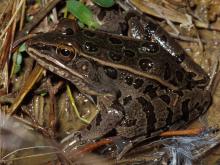
Species Types
Scientific Name
Lithobates sphenocephalus (formerly Rana sphenocephala)
Description
The southern leopard frog is an excellent jumper and quickly leaps into water when startled. From March through July, the males make chuckling or quacking calls from shallow water. Occurs statewide except for the northwestern corner.
Media
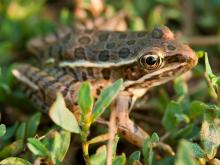
Species Types
Scientific Name
Lithobates blairi (formerly Rana blairi)
Description
A medium-sized spotted frog, the plains leopard frog lives in pastures, prairies, and marshes. The ridge of skin along each side of the back is broken, and a small hind section of it is shifted upward. It occurs nearly statewide, including the Bootheel, but is only rarely present in the Ozarks.
Media
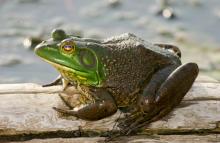
Species Types
Scientific Name
Lithobates catesbeianus (formerly Rana catesbeiana)
Description
The American bullfrog is Missouri’s largest frog. This common species is easy to hear on warm nights when the males call a deep, sonorous “jug-a-rum, jug-a-rum” that can be heard from half a mile away.
See Also
About Reptiles and Amphibians in Missouri
Missouri’s herptiles comprise 43 amphibians and 75 reptiles. Amphibians, including salamanders, toads, and frogs, are vertebrate animals that spend at least part of their life cycle in water. They usually have moist skin, lack scales or claws, and are ectothermal (cold-blooded), so they do not produce their own body heat the way birds and mammals do. Reptiles, including turtles, lizards, and snakes, are also vertebrates, and most are ectothermal, but unlike amphibians, reptiles have dry skin with scales, the ones with legs have claws, and they do not have to live part of their lives in water.





















